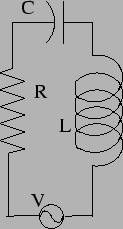



Next: The Raman Effect
Up: Resonance.
Previous: Resonance.
Contents
Figure 4.1:
 |
Electrical Circuits are the most common technological application
where we see resonances. The LCR circuit shown in Figure
4.1 characterizes the typical situation. The circuits
includes a signal generator which produces an AC signal of voltage
amplitude  at frequency at frequency  .
Applying Kirchoff's Law to this circuit we have, .
Applying Kirchoff's Law to this circuit we have,
|
which may be written solely in terms of the charge  as
as
 |
(4.2) |
We see that this is a damped oscillator with an external
sinusoidal force. The equation governing this is
 |
(4.3) |
where
 ,
,  and
and  .
.
We next consider the power dissipated in this circuit. The resistance
is the only circuit element which draws power. We proceed to calculate
this by calculating the impedence
 |
(4.4) |
which varies with frequency. The voltage and current are related as
, which gives the current
 |
(4.5) |
The average power dissipated may be calculated as
 which is
which is
 |
(4.6) |
Problem For an Electrical Oscillator with  and
and
 ,
,
- a.
- what is the natural (angular) frequency
 ? (
? ( )
)
- b.
- Choose
 so that the oscillator is critically
damped. (
so that the oscillator is critically
damped. ( )
)
- c.
- For
 , what is the maximum power that can be
drawn from a
, what is the maximum power that can be
drawn from a  source? (
source? ( )
)
- d.
- What is the FWHM of the peak? (
 )
)
- e.
- At what frequency is half the maximum power drawn? (
 and
and  )
)
- f.
- What is the value of the quality factor
 ? (
? (
 )
)
- g.
- What is the time period of the oscillator? (
 where
where
 and
and
 .)
.)
- h.
- What is the value of the log decrement
 ?
(
?
(
![$\tilde{x}(t)=[\tilde{A} e^{- \beta t}] e^{i \omega t}$](img369.png) ,
,
 )
)




Next: The Raman Effect
Up: Resonance.
Previous: Resonance.
Contents
Physics 1st Year
2009-01-06

![]() as
as
![]() and
and
![]() ,
,
 and
and